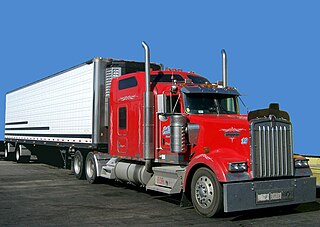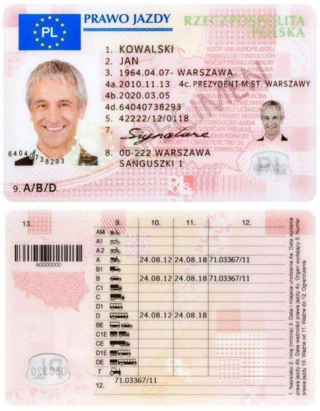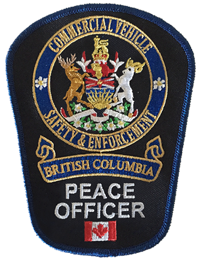Related Research Articles

A department of motor vehicles (DMV) is a government agency that administers motor vehicle registration and driver licensing. In countries with federal states such as in North America, these agencies are generally administered by subnational governments, while in unitary states such as many of those in Europe, DMVs are organized nationally by the central government.
A background check is a process a person or company uses to verify that an individual is who they claim to be, and this provides an opportunity to check and confirm the validity of someone's criminal record, education, employment history, and other activities from their past. The frequency, purpose, and legitimacy of background checks vary among countries, industries, and individuals. An employment background check typically takes place when someone applies for a job, but it can also happen at any time the employer deems necessary. A variety of methods are used to complete these checks including comprehensive database search and personal references.

A commercial driver's license (CDL) is a driver's license required in the United States to operate large and heavy vehicles or a vehicle of any size that transports hazardous materials or more than 15 passengers.

Pilot certification in the United States is typically required for an individual to act as a pilot-in-command of an aircraft. It is regulated by the Federal Aviation Administration (FAA), a branch of the U.S. Department of Transportation (USDOT). A pilot may be certified under 14 Code of Federal Regulations (CFR) Part 61 or 14 CFR Part 141. Pilots may also be certified under 14 CFR Part 107 for commercial drone operations.
The Driver License Compact is an agreement between states in the United States of America. The compact is used to exchange data between motorist's home state and a state where the motorist incurred a vehicular violation. Not all states are members, and states respond to the data differently.

The Real ID Act of 2005 is an Act of Congress that establishes requirements that driver licenses and identification cards issued by U.S. states and territories must satisfy to be accepted for accessing federal government facilities and nuclear power plants and for boarding airline flights in the United States. The requirements include verification of the personal information presented when applying for the identification document, security features on the document, and electronic sharing of databases between states. The act also made various modifications to U.S. immigration law regarding asylum, border security, deportation, and certain work visas.
A Federal Firearms License (FFL) is a license in the United States that enables an individual or a company to engage in a business pertaining to the manufacture or importation of firearms and ammunition, or the interstate and intrastate sale of firearms. Holding an FFL to engage in certain such activities has been a legal requirement within the United States since the enactment of the Gun Control Act of 1968. The FFL is issued by the Bureau of Alcohol, Tobacco, Firearms, and Explosives
TN status is a special non-immigrant classification of foreign nationals in the United States, which offers expedited work authorization to a citizen of Canada or a national of Mexico. It was created as a result of provisions of the North American Free Trade Agreement that mandated simplified entry and employment permission for certain professionals from each of the three NAFTA member states in the other member states. The provisions of NAFTA relevant to TN status were then carried over almost verbatim to the United States–Mexico–Canada Agreement that replaced NAFTA in 2020.

Motor vehicle registration is the registration of a motor vehicle with a government authority, either compulsory or otherwise. The purpose of motor vehicle registration is to establish a link between a vehicle and an owner or user of the vehicle. This link might be used for taxation or crime detection purposes. While almost all motor vehicles are uniquely identified by a vehicle identification number, only registered vehicles display a vehicle registration plate and carry a vehicle registration certificate. Motor vehicle registration is different from motor vehicle licensing and roadworthiness certification.

In the United States, driver's licenses are issued by each individual state, territory, and the District of Columbia rather than by the federal government due to federalism. Drivers are normally required to obtain a license from their state of residence. All states of the United States and provinces and territories of Canada recognize each other's licenses for non-resident age requirements. There are also licenses for motorcycle use. Generally, a minimum age of 16 is required to apply for a non-commercial driver's license, and 18 for commercial licenses which drivers must have to operate vehicles that are too heavy for a non-commercial licensed driver or vehicles with at least 16 passengers or containing hazardous materials that require placards. A state may also suspend an individual's driving privilege within its borders for traffic violations. Many states share a common system of license classes, with some exceptions, e.g. commercial license classes are standardized by federal regulation at 49 CFR 383. Many driving permits and ID cards display small digits next to each data field. This is required by the American Association of Motor Vehicle Administrators' design standard and has been adopted by many US states. According to the United States Department of Transportation, as of 2018, there are approximately 227 million licensed drivers in the United States.

Hours of Service (HOS) regulations are issued by the Federal Motor Carrier Safety Administration (FMCSA) and govern the working hours of anyone operating a commercial motor vehicle (CMV) in the United States. These regulations apply to truck drivers, commercial and intercity bus drivers, and school bus drivers who operate CMVs. These rules limit the number of daily and weekly hours spent driving and working, and regulate the minimum amount of time drivers must spend resting between driving shifts. For intrastate commerce, the respective state's regulations apply.
The motor carrier safety rating is an evaluation given to an interstate commercial motor carrier by the Federal Motor Carrier Safety Administration (FMCSA).
The New York State Department of Motor Vehicles is the department of the New York state government responsible for vehicle registration, vehicle inspections, driver's licenses, learner’s permits, photo ID cards, and adjudicating traffic violations. Its regulations are compiled in title 15 of the New York Codes, Rules and Regulations.
Title 1 of the Code of Federal Regulations, titled General Provisions, is a United States federal government regulation.
Criminal records in the United States contain records of arrests, criminal charges and the disposition of those charges. Criminal records are compiled and updated on local, state, and federal levels by government agencies, most often law enforcement agencies. Their primary purpose is to present a comprehensive criminal history for a specific individual.
The California Bureau of Real Estate Appraisers (BREA) is a division of the California Department of Consumer Affairs responsible for real estate appraiser licensing and certification in California.

The Hazardous Materials Transportation Act (HMTA), enacted in 1975, is the principal federal law in the United States regulating the transportation of hazardous materials. Its purpose is to "protect against the risks to life, property, and the environment that are inherent in the transportation of hazardous material in intrastate, interstate, and foreign commerce" under the authority of the United States Secretary of Transportation.

A driver's license is a legal authorization, or the official document confirming such an authorization, for a specific individual to operate one or more types of motorized vehicles—such as motorcycles, cars, trucks, or buses—on a public road. Such licenses are often plastic and the size of a credit card.

In Puerto Rico, the law regulates the sale, possession, and use of firearms and ammunition. As an unincorporated territory of the United States, Puerto Rico is an "appurtenant jurisdiction" to which the Insular cases apply. Except for provisions of the U.S. Constitution that apply by their own force, only those constitutional provisions extended by Congress apply to any of the appurtenant jurisdictions.

British Columbia Commercial Vehicle Safety & Enforcement is a provincial law enforcement agency that is responsible for the compliance and enforcement of the commercial transport sector, protection of the environment and transportation infrastructure of British Columbia, increasing road safety and protecting the motoring public.
References
- ↑ "National Driver Register (NDR) | National Highway Traffic Safety Administration (NHTSA)". Archived from the original on 2013-06-21. Retrieved 2013-05-23.
- ↑ "23 CFR Appendix A to Part 1327, Abridged Listing of the American Association of Motor Vehicle Administrators Violations Exchange Code, Used by the NDR for Recording...License Denials, Withdrawals, and Convictions of Motor Vehicle-Related Offenses". LII / Legal Information Institute. Retrieved 12 August 2017.
- ↑ "Electronic Code of Federal Regulations". Archived from the original on 2010-06-19. Retrieved 2010-08-25.
- ↑ "Electronic Code of Federal Regulations". Archived from the original on 2011-06-12. Retrieved 2011-08-01.
- ↑ "Problem Driver Pointer System (PDPS)". AAMVA PDPS.
- ↑ Roddy, William. "§1327.1 Scope". eCFR--Code of Federal Regulations. U.S. Government Printing Office. Retrieved 23 September 2015.
- ↑ "NDR Frequently Asked Questions" (PDF).
{{cite web}}: CS1 maint: url-status (link)